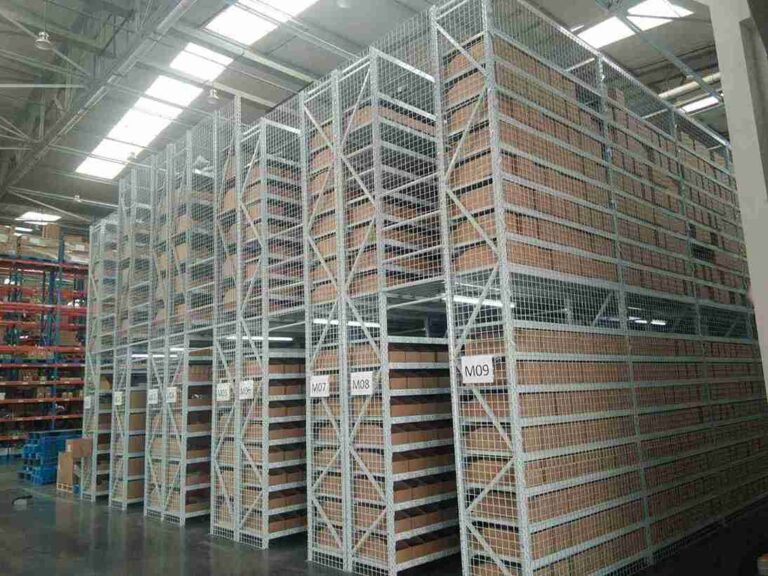📐 "First 50 Enterprise Queries Get Custom 3D Warehouse Design" Plan

Introduction: Revolutionizing Warehouse Storage with Multi-Level Narrow Aisle Systems
In an era where warehouse space is at a premium, multi-level narrow aisle storage has emerged as the go-to solution for businesses looking to maximize vertical space without sacrificing accessibility. Unlike traditional racking systems, multi-level narrow aisle storage allows warehouses to double or even triple storage capacity while maintaining efficient material flow.
This in-depth guide explores why multi-level narrow aisle storage is transforming modern warehousing, covering:
- How multi-level narrow aisle storage works and why it outperforms conventional systems
- Key benefits, including cost savings, efficiency gains, and scalability
- Design considerations for seamless integration into existing facilities
- Safety protocols to ensure smooth operations
- Real-world success stories from leading industries
By the end, warehouse managers and logistics professionals will understand why multi-level narrow aisle storage is the smartest expansion strategy for high-density operations.

1. What is Multi-Level Narrow Aisle Storage?
Multi-level narrow aisle storage (MLNA) is a high-density warehousing solution that utilizes vertical stacking to optimize space in facilities with limited square footage. By incorporating narrow aisles (as tight as 5-6 feet) and specialized forklifts, warehouses can store more inventory in the same footprint while maintaining full accessibility to every pallet.
1.1 Core Components of Multi-Level Narrow Aisle Storage
- Heavy-duty steel framing – Provides structural integrity for multi-tiered platforms
- Narrow aisle forklifts – Designed for tight turns and high-reach capabilities
- Elevated work platforms – Allow order pickers to operate safely at multiple levels
- Integrated safety systems – Includes guardrails, anti-collision sensors, and fall protection
1.2 Industries That Benefit Most from Multi-Level Narrow Aisle Storage
- E-commerce fulfillment centers – High SKU counts demand dense storage
- Cold storage warehouses – Maximizes space in expensive refrigerated environments
- Automotive parts distributors – Ideal for bulky but lightweight inventory
- Pharmaceutical and medical supply chains – Ensures FIFO compliance with direct access
2. Why Multi-Level Narrow Aisle Storage Outperforms Traditional Racking
2.1 Unmatched Storage Density
Traditional selective pallet racking requires 10-13 ft aisles, whereas multi-level narrow aisle storage reduces this to 5-6 ft, allowing 40-60% more pallet positions in the same space.
2.2 Faster Order Fulfillment
- Reduced travel time – Narrow aisles mean shorter distances for forklifts
- Direct access to every pallet – No need for deep-reach or drive-in configurations
- Compatibility with automation – Works seamlessly with AS/RS and robotic retrieval systems
2.3 Cost-Effective Expansion
- Avoids costly facility expansions – No need for additional real estate
- Lower energy consumption – Smaller footprint reduces HVAC and lighting costs
- Scalable for future growth – Additional levels can be added as needed
3. Comparing Multi-Level Narrow Aisle Storage to Other Systems
| Feature | Multi-Level Narrow Aisle Storage | Selective Pallet Racking | Drive-In Racking |
|---|---|---|---|
| Aisle Width | 5-6 ft | 10-13 ft | 8-10 ft |
| Storage Density | Highest | Moderate | High |
| Accessibility | Best (direct access to all pallets) | Excellent | Limited (LIFO only) |
| Best For | Fast-moving SKUs, high-density needs | General warehousing | Bulk storage with low turnover |
4. Designing an Efficient Multi-Level Narrow Aisle Storage System
4.1 Warehouse Layout Optimization
- Aisle width planning – Must match forklift specifications
- Column spacing – Ensures structural stability for multi-tiered loads
- Clear height utilization – Maximizes vertical storage without wasted space
4.2 Choosing the Right Equipment
- Narrow aisle reach trucks (e.g., Crown, Raymond, Hyster)
- Man-aboard order pickers for multi-level picking
- Automated guided vehicles (AGVs) for fully automated retrieval
4.3 Safety and Compliance Considerations
- OSHA & ANSI standards for elevated work platforms
- Seismic reinforcement in earthquake-prone regions
- Fire suppression systems integrated into racking
5. Safety Best Practices for Multi-Level Narrow Aisle Storage
- Comprehensive forklift operator training – Narrow aisles require precision driving
- Anti-collision sensors to prevent accidents in tight spaces
- Clear aisle markings for traffic flow optimization
- Regular structural inspections to ensure racking integrity
6. Real-World Success Stories with Multi-Level Narrow Aisle Storage
6.1 E-Commerce Giant Increases Storage by 85%
A leading online retailer implemented multi-level narrow aisle storage, reducing floor space needs by 40% while increasing SKU capacity.
6.2 Pharmaceutical Warehouse Doubles Cold Storage Efficiency
A medical supplier used multi-level narrow aisle storage to maximize refrigerated space, ensuring compliance with strict temperature controls.
7. The Future of Multi-Level Narrow Aisle Storage
- AI-powered inventory tracking for real-time stock management
- Robotic pallet shuttles for fully automated high-density storage
- Modular designs allowing easy reconfiguration as needs evolve
Conclusion: Is Multi-Level Narrow Aisle Storage the Right Choice?
For warehouses struggling with space constraints but growing inventory demands, multi-level narrow aisle storage offers the most efficient, scalable, and cost-effective solution. By leveraging vertical space and advanced material handling, businesses can boost productivity, reduce operational costs, and future-proof their storage strategy.
Companies considering multi-level narrow aisle storage should consult with experienced storage solution providers to design a system tailored to their specific needs.
FAQs
1. How much does a multi-level narrow aisle storage system cost?
Costs range from 150 per square foot, depending on height, materials, and automation features.
2. Can existing warehouses be converted to multi-level narrow aisle storage?
Yes, but structural assessments are required to ensure floor strength and ceiling clearance.
3. What’s the maximum height for multi-level narrow aisle storage?
Most systems support 40-50 feet, but taller installations require special engineering approvals.
4. Is multi-level narrow aisle storage compatible with automation?
Absolutely—many facilities integrate AS/RS and robotic retrieval for maximum efficiency.
5. How do I ensure safety in narrow aisle operations?
Operator training, collision avoidance systems, and clear aisle markings are essential.




